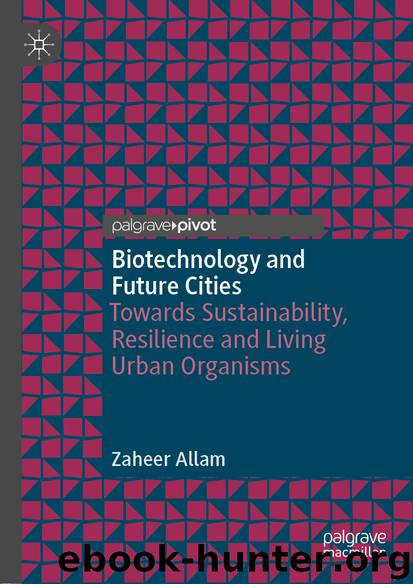Biotechnology and Future Cities by Zaheer Allam

Author:Zaheer Allam
Language: eng
Format: epub
ISBN: 9783030438159
Publisher: Springer International Publishing
Biomimicry, Energy Policy and Planning, and Urban Morphology
Looking back at the energy sector, it can be observed that traditional energy planning led to the creation of centralized energy power plants, which may have worked perfectly then in most parts of the world. From the literature, and also from the understanding that most, if not all of those traditional energy plants, relied on either fossil fuels, nuclear, water, and/or wind, but centralization of the plant was based on a number of factors including. First, it is true that the population served was not as many as today; hence, centralized power plants could be fashioned to comfortably meet the energy demands of a given locality. The problems of sprawl that are currently confronting many major cities were somehow unheard off; hence, it was convenient to plan the distribution channels and strategies, to satisfy the need of only a small segment that constituted end-users. Second, in terms of engineering planning, centralized energy power plants worked, and is still preferred as majority of the processes are centralized, and most of the mechanical parts are geographically located in the same location; thus, issues like monitoring, maintenance, and upgrade are relatively manageable. In addition, the geographical location of these plants, mostly relatively far from residential areas, offers some direct and indirect benefits, both to the utility companies and to the residents. Therefore, issues like noise pollution and emergencies that may arise in case of accidents are highly minimized, hence reducing possible losses. They also allow for novel planning of cities and towns as only distribution lines and substations have to be put in consideration. More importantly, they allow for maximum utilization of land and areas that in most cases are considered derelict, inhabitable, and of little value.
However, there are some weighty issues, especially in our modern times lead to the disapproval of these centralized power plants. A major issue is the cost implications that range from distribution costs, maintenance, blackouts, upgrades, and environmental costs. In terms of distribution, it is noted that these energy plants rely on networks of high-voltage transmission lines that run for substantial distances that link plants to end-users through the main grid. The costs of purchasing, installing, maintaining, and upgrading these lines have been noted to be relatively high, and in most cases, they are borne by the final consumer via the pricing system that utility companies use. During maintenance, or in cases of breakdowns or emergencies of either the plants or the transmission lines, the end-users bear the blunt of insufficient supply or total blackout. A case in point is the Fukushima Daiichi accident that was triggered by a major earthquake causing all the three reactor cores that were located in same area to meltdown within three days of the earthquake. Besides disruption of power supply, the accident caused major concerns, as there were fears of contamination from nuclear radioactive, which were leaking from the reactors. The ultimate consequence of the accident was the writing off of four main reactors, evacuation
Download
This site does not store any files on its server. We only index and link to content provided by other sites. Please contact the content providers to delete copyright contents if any and email us, we'll remove relevant links or contents immediately.
| Automotive | Engineering |
| Transportation |
Whiskies Galore by Ian Buxton(41929)
Introduction to Aircraft Design (Cambridge Aerospace Series) by John P. Fielding(33081)
Small Unmanned Fixed-wing Aircraft Design by Andrew J. Keane Andras Sobester James P. Scanlan & András Sóbester & James P. Scanlan(32760)
Craft Beer for the Homebrewer by Michael Agnew(18189)
Turbulence by E. J. Noyes(7970)
The Complete Stick Figure Physics Tutorials by Allen Sarah(7331)
Kaplan MCAT General Chemistry Review by Kaplan(6890)
The Thirst by Nesbo Jo(6869)
Bad Blood by John Carreyrou(6578)
Modelling of Convective Heat and Mass Transfer in Rotating Flows by Igor V. Shevchuk(6404)
Learning SQL by Alan Beaulieu(6231)
Weapons of Math Destruction by Cathy O'Neil(6201)
Man-made Catastrophes and Risk Information Concealment by Dmitry Chernov & Didier Sornette(5946)
Digital Minimalism by Cal Newport;(5693)
Life 3.0: Being Human in the Age of Artificial Intelligence by Tegmark Max(5502)
iGen by Jean M. Twenge(5381)
Secrets of Antigravity Propulsion: Tesla, UFOs, and Classified Aerospace Technology by Ph.D. Paul A. Laviolette(5328)
Design of Trajectory Optimization Approach for Space Maneuver Vehicle Skip Entry Problems by Runqi Chai & Al Savvaris & Antonios Tsourdos & Senchun Chai(5032)
Pale Blue Dot by Carl Sagan(4944)
